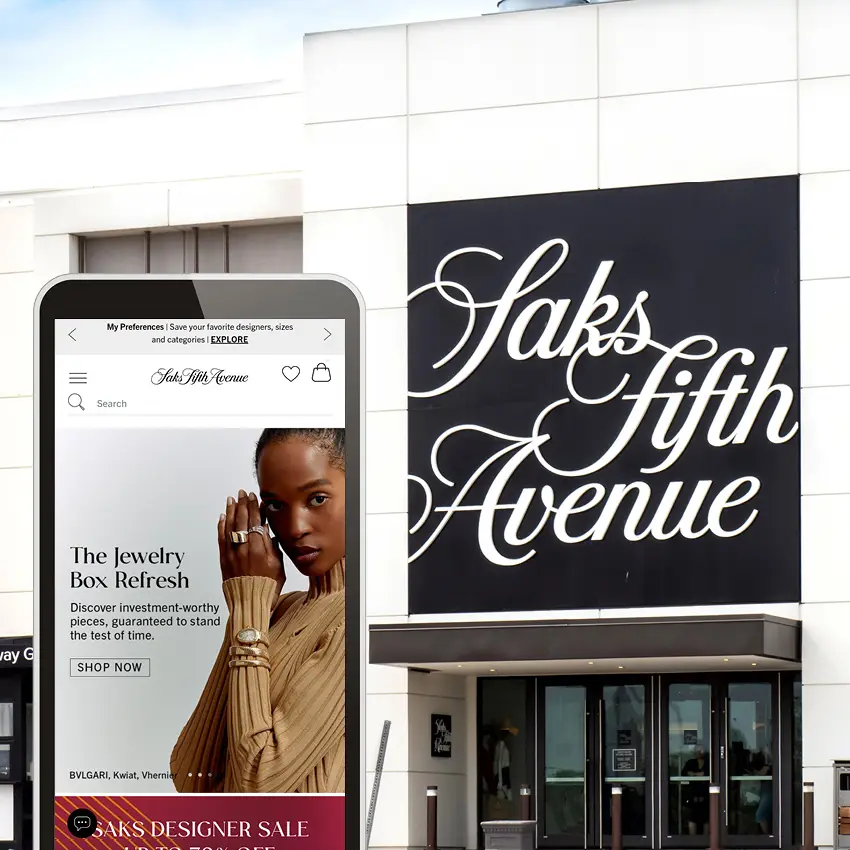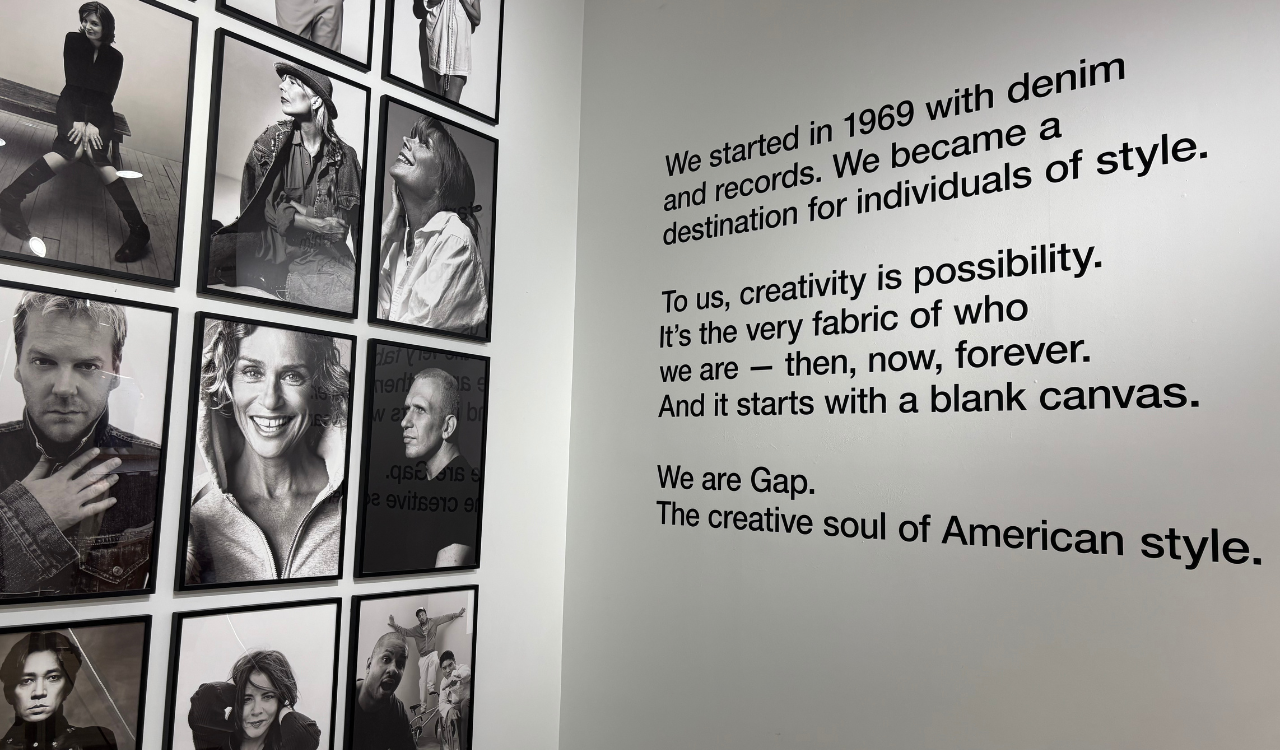When news broke recently that HBC was splitting Saks Fifth Avenue into two, spinning off its ecommerce business from its brick-and-mortar stores, speculation swirled about the thinking behind the move. That news was followed shortly by an announcement that it was doing the same for its off-price Saks Off 5th company, separating the stores from its digital platform.
The Joys of Going Private
Since going private in 2019, HBC CEO Richard Baker doesn’t have to answer to the Street. He has a free pass to assert that the Saks move is “redefining the luxury shopping ecosystem” in order to “unlock significant value within our company’s assets.”
Saks is taking out the friction that the customer had working with SFA online, behaving as a pure play. They are going to invest in all the steps along the customer journey to bring the SFA digital experience where it should be and akin to where it is in the stores, which will enable growth for both and to drive that omnichannel experience.
The same thinking applies to the Saks Off 5th split as redefining the off-price luxury sector. He also stated that O5, Saks Off 5th new brand, the change was motivated by “a significant opportunity to capture additional market share by further expanding its digital capabilities.”
However, few could make sense of the breakup. TRR’s sagacious reporter Warren Shoulberg, contended that Saks was “taking a giant leap backwards by splitting off ecommerce” in a retail industry where integrating physical retail with ecommerce has become “standard best practice.”
And our leader, Robin Lewis got even more provocative, suggesting that Baker is following the Eddie Lampert’s Sears “playbook.”
” I will state my opinion right up front. I believe Richard Baker’s move to split the Saks Fifth Avenue and its ecommerce business into separate companies, which he calls ‘unlocking value,’ is simply applying a fancy buzzword, disguising what will ultimately lead to a real estate play.” Both Baker and Lampert built their multimillion business empires on real estate and investments, not in retail where they eventually landed.
A Matter of Debate
Since nine times out of ten, I agree with Shoulberg. And as the saying goes, Robin Lewis has probably forgotten more about retail than I will ever know, so I was inclined to let this story about the HBC decision slide — but it nagged at me. Why? The strategies, management structure and skillsets needed to run a successful brick-and-mortar retail business are so different from those needed for a successful ecommerce business, especially in luxury retail.
I came to the conclusion that because the experience of shopping in a luxury department store differs so dramatically from shopping online, it may well make sense to challenge omnichannel retail’s conventional wisdom and run the store and ecommerce businesses separately.
Chicken or the Egg?
“Big retailers are realizing it’s no longer good enough to basically have a website that allows for online shopping. If that is your play, it’s only going to be marginally additive to your top line,” says Alex Atzberger, CEO of Optimizely (formerly known as Episerver) and previously president of SAP Customer Experience. “Retailers have to move from providing a website to providing an online shopping experience. It’s not enough to say you can find the same assortment online as when you come to our stores. Ecommerce is in many ways a separate business requiring a different way to engage with customers than in the store.”
Digital native retailers that are now opening brick-and-mortar stores are in a very different place than established retailers that cobbled on a website to their established businesses. Digital natives can design stores to a different model, select the best locations for where people are shopping today, not yesterday, and test, try and learn to optimize both aspects of the business.
Established retailers, on the other hand, with their entrenched brick-and-mortar footprints don’t have that flexibility. “Omnichannel was all about bringing it together under one house,” Atzberger explains. “But we need to go full circle and define who our competition really is — another brick-and-mortar retailer with a website or an ecommerce player that has a totally different mindset. It’s very difficult to run a successful physical retail business then apply the same mentality to being a true ecommerce competitor.”
Transformations and Transitions
The last 10 years have seen a dramatic restructuring of the retail landscape, accelerated by the pandemic. Statista estimates worldwide ecommerce sales will grow from about 14 percent of retail sales in 2019 to nearly 22 percent by 2024.
Looking further out, Grandview Research estimates global ecommerce will experience a 14.7 percent CAGR between 2020 and 2027. Brick-and-mortar retail will be lucky if it does one-third of that. The prospects to capture a greater share of each channel’s respective growth will be different depending upon whether you’re a brick-and-mortar retailer with a website or an ecommerce retailer with stores.
Speaking for Saks and spinning off its ecommerce business, Marc Metrick, Saks Fifth Avenue CEO, says, “We want to move the center of gravity [of the company] and that is digital. That is where the customer is going. The addressable market for luxury goods over the next couple of years is going to triple in ecommerce. We want to make sure we are positioned for where the customer is going.”
Investing for Survival…or Growth
As in all business decisions, finances are at the core and the costs to run brick-and-mortar and ecommerce businesses are very different. Operating a store where merchandise must be displayed for customers who must be greeted and served requires entirely different financial and management structures than operating an ecommerce warehouse with only stock pickers and forklift operators touching the merchandise. Further, the strategies required to grow them differ too. Metrick says, “We were managing the business for earnings and didn’t have that customer growth mindset.”
The earnings mindset Metrick speaks of was based on decades of store-centric thinking. “You need to build out the right investments in your branding and marketing to attract people to the different channels,” says Atzberger. “Before you took a brick-and-mortar retailer mindset to the digital world. But we have discovered the entire customer journey is quite different. What you can do to guide that journey online is very different from what you can and must do in a physical environment.” Matthew Katz, managing partner of global strategic advisory firm SSA & Company, concurs. “The luxury consumer is learning to enjoy the digital connection and the digital experience. However, the luxury customer is one who has always enjoyed a store experience.”
Both the online store and the physical store may share the same merchandise assortment, but the customer experience is totally different, requiring different management, investments and financial structures. “Looking at omnichannel retailers, there isn’t much financial transparency. It’s very difficult to truly understand the profitability and performance of the online channel versus the physical because much of the infrastructure is shared,” Katz observes. He adds, “Much of the capital goes to growing the digital business with capital that could be earmarked for the stores getting hijacked. The result is the stores get old and tired and they underperform.”
Novel Model
The split of Saks Fifth Avenue from Saks.com offers the potential to disentangle the capital and human resource investments to the different sides of the business so that they are less competitive and more complementary. Metrick reports that each separate entity will charge fees to the other for services provided. However, there will still be some shared responsibilities with chief merchandising officer Tracy Margolies managing all buying and merchandising for both businesses.
Service agreements between Saks Fifth Avenue and Saks.com have been put into place to handle the cross-company charges. Metrick explains these agreements formalize what they have always done across channels, but the new arrangement now allows for both entities to properly invest in their respective models. So far, he reports, “strong performance” across ecommerce and the stores thanks to the new arrangement.
The new corporate structure will also bring clarity to staff members who may in the past have had responsibility for meeting performance objectives without full authority over them. “I commend Saks in the clarity of purpose it brings the organizational structure,” Katz says. “It will be very clear whom you report to, which division you support and which company you work for. It will make a clear distinction as to where people spend their time.”
And that clarity of purpose for all in both organizations will be to serve the customer wherever and however he or she chooses to interact with the brand. “What we are trying to accomplish here is to deliver great fashion with ease,” Metrick shares. “We are taking out the friction that the customer had working with SFA online. We get to behave as a ‘pure-play.’ We are going to invest in all the steps along the customer journey to bring the SFA digital experience where it should be and akin to where it is in the stores. That will enable growth for both and to drive that omnichannel experience.”
Breaking Free from the Anchor
Luxury department stores have been treading water for years – closing stores left, right and center – if they haven’t already sunk like Barney’s. Their only bright spot has been their digital platforms, which suggests that decoupling the two entities, Saks Fifth Avenue stores from Saks.com, might not be a bad idea.
In effect, the luxury department store today – called an anchor store in retail parlance – may be an anchor dragging down growth across the business. If the rising tide in retail is ecommerce, then decoupling the two sides of the business may well allow both businesses to rise with their separate tides.
“There is a business model that works for stores and another for pure-play digital business,” Metrick says. “My one-year plan is to acquire new customers and spend into that marketing investment. As we make that investment, we are going to continue to be the Saks that everyone knows and that has tremendous brand recognition and power. Our customer acquisition cost (CAC) will be more efficient because our brand recognition is so great. We will be able to spend up and win the customer acquisition game. We are growth focused now,” Metrick concludes.
The jury is out on how this will end. Baker’s move is contrary to omnichannel retail strategy, and once the details emerge on how to manage the supply chain and fulfill orders between the two businesses we’ll see if this is original thinking or another real estate or accounting ploy. It’s never business as usual with Baker and HBC.





